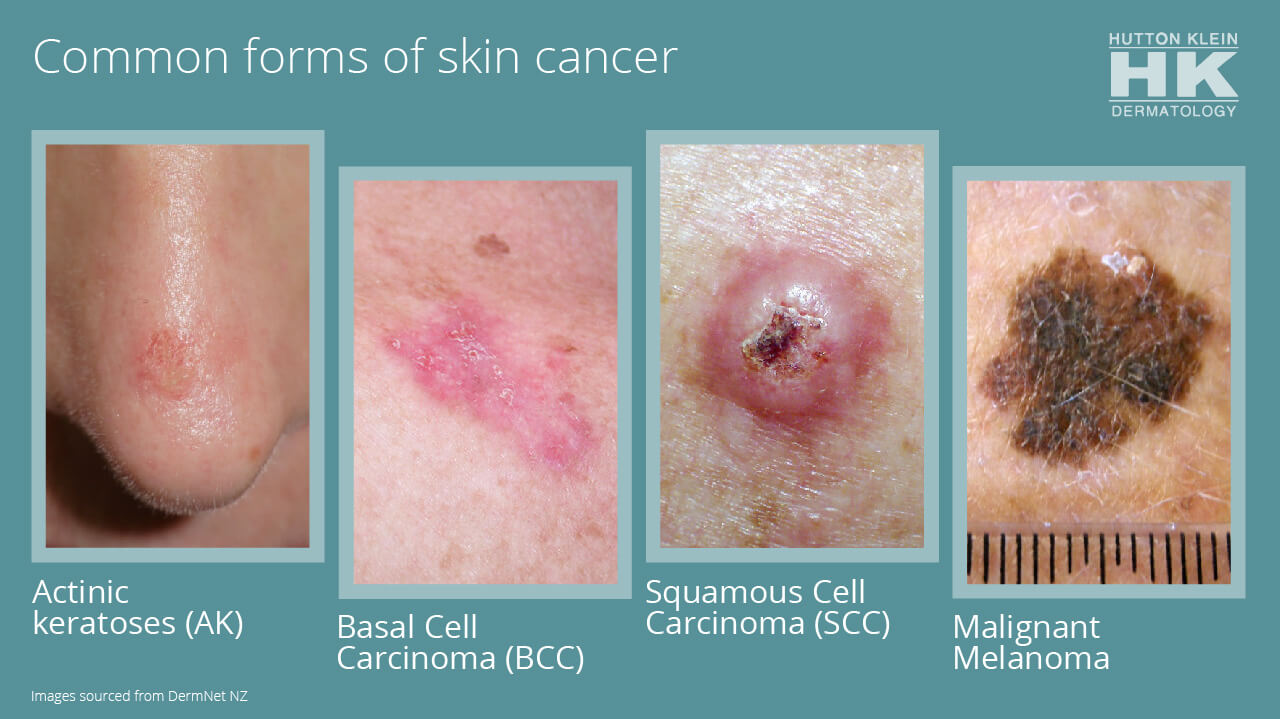
The most prevalent form of cancer, skin cancer can affect anyone at any age but often occurs as a result of years of sun exposure. Fair-skinned people who sunburn easily are at a particularly high risk for developing skin cancer. Other less important factors include repeated medical and industrial X-ray exposure, scarring from diseases or burns, occupational exposure to compounds such as coal tar and arsenic, and family history. HK Dermatology in San Juan Capistrano, California, offers advanced skin cancer treatments, including Mohs surgery and superficial radiation therapy. With early detection, most skin cancers can be cured, so don’t hesitate to schedule an exam for a changing mole or a dry, scaly patch of skin. Call today to book an appointment or use the online scheduler.
Request an Appointment
The infographic has been created from an article containing more pictures of skin cancer.
What does skin cancer look like?
Skin cancer is an abnormal growth of cells that often appears on areas of your skin that receive the most exposure to the sun’s harmful, ultraviolet rays, such as your face, ears, neck, hands, or arms. Skin cancer looks different depending on what type of cancer it is. For more information take a look at this useful guide: https://miiskin.com/skin-cancer-signs-to-be-aware-of/
Actinic keratoses (AK)
In its earliest stage, skin cancer may look like a dry, scaly patch of skin, called actinic keratoses. AKs are precancerous growths or spots on your skin that typically develop on people with fair skin who are over 40 years old.
Left untreated, AKs can progress into squamous cell carcinoma, a more serious form of skin cancer. Jeffrey Klein, MD, is a highly skilled dermatologic surgeon at HK Dermatology. Dr. Klein and the dermatology team successfully treat AKs with cryotherapy (freezing), photodynamic blue light therapy, laser surgery, chemical peels, and topical chemotherapy, curettage, or other surgical procedures. Basal cell carcinoma (BCC)
Basal cell carcinoma is the most common type of skin cancer and usually looks like a pearl-like, flesh-colored bump on your skin. BCC can also look like a pink-colored bump on your skin. Like AKs, BCCs are common on areas of your body that have been exposed to the sun over the years, especially in fair-skinned people. Untreated, the cancer often will begin to bleed, crust over, heal, and repeat the cycle.
Early diagnosis and treatment are important so basal cell carcinoma doesn’t spread into surrounding tissue, nerves, or bones.
Basal Cell Carcinoma
This is the most common type of skin cancer and appears frequently on the head, neck and hands as a small, fleshy bump. Nodule, or red patch. Other parts of the body may be affected as well. Basal cell carcinomas, frequently found in fair-skinned people, can take many months or years to grow. Untreated, the cancer often will begin to bleed, crust over, heal and repeat the cycle. It can extend below the skin to the bone and nerves, causing considerable local damage.
Squamous cell carcinoma (SCC)
The second most common type of skin cancer, squamous cell carcinoma typically appears as a red firm bump or a scaly patch of skin. It may also look like a sore that heals and then reopens repeatedly. SCCs can grow deep into your skin and cause permanent damage. SCC can develop into a large mass and become invasive.
Early diagnosis and treatment can prevent SCC from metastasizing to other parts of your body.
Malignant melanoma
Malignant melanoma is the deadliest type of skin cancer that often develops in a mole or as a new dark spot on your skin. It is projected that more than 108,000 Americans will develop melanoma annually and an estimated 8,000 Americans will die from melanoma.
Melanoma begins in melanocytes, the skin cells that produce the dark protective pigment called melanin which makes the skin tan. Since the melanoma cells usually continue to produce melanin, the cancer appears in mixed shades of tan, brown, and black; although, it can also be red or white. Melanoma can metastasize making early detection and treatment essential. Melanoma may appear suddenly or begin in or near a mole or another dark spot that has been on the skin for years. Any changing mole must be examined by a dermatologist.
Early diagnosis and treatment are critical to prevent serious, life-threatening health complications.
What types of treatments are available for skin cancer?
Treatment for skin cancer depends on the type of cancer you have, where it’s located, and its severity. Dr. Klein and Dr. Kassardjian are experienced dermatologic surgeons proficient in a variety of skin cancer treatments, including Mohs surgery. During Mohs surgery, your doctor removes the affected layers of skin one at a time, examining them closely under a microscope for abnormal cells.
Dr. Klein or Dr. Kassardjian often performs Mohs surgery to remove basal cell carcinomas or squamous cell carcinomas. The procedure is highly effective at removing all abnormal cells while preserving the surrounding skin, so it’s ideal for skin cancer on your face, where you want to preserve as much skin as possible. Other treatments include:
- Superficial radiation therapy with SRT-100™
- Excision
- Cryotherapy
- Photodynamic therapy
- Chemotherapy
The team at HK Dermatology recommends the most effective treatments based on your individual situation.
How can I prevent skin cancer?
You should take steps every day to prevent skin cancer, such as:
- Staying out of direct sunlight from 10 am – 4 pm
- Avoiding tanning beds
- Using broad-spectrum sunscreen every day
- Examining your skin monthly and keep a photo record of the appearance of your skin and moles so that you can more easily identify changes. To help you do this HK Dermatology has partnered with Miiskin to offer you a secure, purpose built, smart phone app which reminds and assists you to take high quality skin and mole photos, and helps you compare the photos for changes over time, by offering side by side image comparisons. To access our app please visit https://miiskin.com/hkdermatology/
- Seeing your dermatologist at least once a year
When you know what your skin looks like, it’s easier to notice any changes. Call today to schedule a skin cancer screening or use the online booking system to request an appointment.
